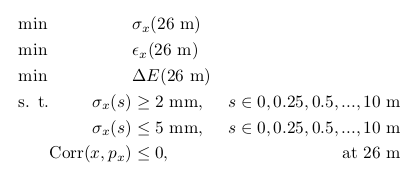opal AT lists.psi.ch
Subject: The OPAL Discussion Forum
List archive
- From: "Snuverink Jochem (PSI)" <jochem.snuverink AT psi.ch>
- To: "Bellotti Renato (PSI)" <renato.bellotti AT psi.ch>
- Cc: "opal AT lists.psi.ch" <opal AT lists.psi.ch>
- Subject: Re: [Opal] Optimiser
- Date: Wed, 6 May 2020 16:23:34 +0000
- Accept-language: en-US, de-CH
Dear Renato,
The optimiser is not optimised to find the first generation quickly. There is an optimizer flag called `INITIAL_OPTIMIZATION`, if you set this to TRUE (default FALSE), it will speed up the first generation. It is mostly for finding the last feasible individuals, so it will probably not help in your case.
This sounds interesting. What does this option do, and what do you mean by "the last feasible individuals"?
What you can also do is generate the feasible solutions with the surrogate model, make a JSON generation file from them, and start the optimisation with that generation (`STARTPOPULATION`).
This is not possible because I'd like to calculate the speedup of running an optimisation with the surrogate model vs. with OPAL.
Cheers, Jochem
Sent: Wednesday, May 6, 2020 3:46 PM
To: Snuverink Jochem (PSI)
Cc: opal AT lists.psi.ch
Subject: Re: [Opal] Optimiser
Dear Jochem,
Thanks for your answer.
Did you verify that the solutions you found with the surrogate model are also solutions with OPAL? (That is run the OPAL-simulation with that input and verify that it fulfils all constraints).
I have fed the Python-optimised configurations to OPAL, and the constraints are still fulfilled.
This sounds interesting. What does this option do, and what do you mean by "the last feasible individuals"?The optimiser is not optimised to find the first generation quickly. There is an optimizer flag called `INITIAL_OPTIMIZATION`, if you set this to TRUE (default FALSE), it will speed up the first generation. It is mostly for finding the last feasible individuals, so it will probably not help in your case.
This is not possible because I'd like to calculate the speedup of ranning an optimisation with the surrogate model vs. with OPAL.What you can also do is generate the feasible solutions with the surrogate model, make a JSON generation file from them, and start the optimisation with that generation (`STARTPOPULATION`).
Hope that helps,Jochem
This helps a lot, thank you!
Cheers,
Renato
From: opal-request AT lists.psi.ch <opal-request AT lists.psi.ch> on behalf of Renato Bellotti <renato.bellotti AT psi.ch>
Sent: Tuesday, May 5, 2020 4:10 PM
To: opal AT lists.psi.ch
Subject: [Opal] OptimiserDear OPAL developers,
I am experiencing problems with the optimiser. I am trying to solve the following problem:
You can see that I try to restrict the beam size within the first 10m of the accelerator.
Unfortunately, the optimiser does not find a single feasible individual, although it has tried > 7500 configurations.
I know that the problem has solutions that fulfil the constraint: Thanks to an ML surrogate model, I was able to run the optimisation with the pymoo Python library.
I am now a bit at a loss that OPAL cannot solve the problem while the Python library can. Am I doing something wrong in the config file (see appendix)?
I'm looking forward to your answers,
Renato
- [Opal] Optimiser, Renato Bellotti, 05/05/2020
- Re: [Opal] Optimiser, Snuverink Jochem (PSI), 05/06/2020
- Re: [Opal] Optimiser, Renato Bellotti, 05/06/2020
- Re: [Opal] Optimiser, Snuverink Jochem (PSI), 05/06/2020
- Re: [Opal] Optimiser, Renato Bellotti, 05/06/2020
- Re: [Opal] Optimiser, Snuverink Jochem (PSI), 05/06/2020
Archive powered by MHonArc 2.6.19.
